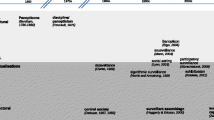Abstract
Neighborhood watch grew out of a movement in the USA during the late 1960s that promoted greater involvement of citizens in the prevention of crime. Recent estimates suggest that over a quarter of the UK population and over 40% of the US population live in areas covered by neighborhood watch schemes. The current paper presents the results of a recent systematic review of evaluations of neighborhood watch. The main findings of the narrative review were that about half of the schemes evaluated showed that neighborhood watch was effective in reducing crime, with most of the other evaluations having uncertain effects. The main findings of the meta-analysis were that 15 of the 18 studies provided evidence that neighborhood watch reduced crime. While the results of the review are encouraging, it was concluded that more high-quality research needs to be done to help explain why study variations exist.
Similar content being viewed by others
References
Bennett, T. H. & Wright, R. (1984). Burglars on burglary: Prevention and the offender. Aldershot, U.K.: Gower.
Greenberg, S. W., Rohe, W. M. & Williams, J. R. (1985). Informal citizen action and crime prevention at the neighborhood level. Washington, D.C.: Government Printing Office.
Laycock, G. (1985). Property marking: A deterrent to domestic burglary? Crime Prevention Unit Paper 3. London: Home Office.
Lipsey, M. W. & Wilson, D. B. (2001). Practical meta-analysis. Thousand Oaks, CA: Sage.
National Crime Prevention Council (2001). The 2000 National Crime Prevention Survey. Washington, D.C.: National Crime Prevention Council.
Rosenbaum, D. P. (1987). The theory and research behind neighborhood watch: Is it a sound fear and crime reduction strategy? Crime and Delinquency 33, 103–134.
Sherman, L. W. (1997). Policing for crime prevention. In L. W. Sherman, D. C. Gottfredson, D. L. MacKenzie, J. Eck, P. Reuter & S. Bushway (Eds.), Preventing crime: What works, what doesn’t, what’s promising (pp. 8-1–8-58). Washington, D.C.: US Office of Justice Programs.
Sims, L. (2001). Neighborhood watch: Findings from the 2000 British Crime Survey. (Research Findings 150.) London: Home Office.
Titus, R. (1984). Residential burglary and the community response. In R. V. G. Clarke & T. Hope (Eds.), Coping with burglary (pp. 97–130). Boston: Kluwer-Nijhoff.
Turner, B. W. M. & Barker, P. J. (1983). Study tour of the United States of America: 7th March 1983 to 21st March 1983. London: Metropolitan Police.
Wilson, D. B., Mitchell, O. & MacKenzie, D. L. (2006) A systematic review of drug court effects on recidivism. Journal of Experimental Criminology (in press).
Studies included in the review
Anderton, K. J. (1985). The effectiveness of Home Watch schemes in Cheshire. Chester, UK: Cheshire Constabulary.
Bennett, T. H. (1990). Evaluating neighbourhood watch. Cambridge Studies in Criminology LXI. Aldershot, UK: Gower.
Bennett, S. F. & Lavrakas, P. J. (1989). Community-based crime prevention: An assessment of the Eisenhower Foundation’s neighborhood program. Crime and Delinquency 35, 345–364.
Cirel, P., Evans, P., McGillis, D. & Whitcomb, D. (1977). Community Crime Prevention Program, Seattle: an exemplary project. Washington D.C.: Government Printing Office.
Forrester, D., Chatterton, M., & Pease, K. (1988) The Kirkholt Prevention Project, Rochdale. Crime Prevention Unit, Paper 13. London: Home Office.
Forrester, D., Frenz, S., O’Connell, M. & Pease, K. (1990). The Kirkholt Burglary Prevention Project: Phase II. Crime Prevention Unit, Paper 23. London: Home Office.
Henig, J. R. (1984). Citizens against crime: An assessment of the neighborhood watch program in Washington, D.C. (Occasional Paper, Center for Washington Area Studies.) Washington: George Washington University.
Hulin, J. O. (1979). Community-based crime prevention project. Crime Prevention Review 6, 26–34.
Husain, S. (1990). Neighborhood watch and crime: An assessment of impact. London: Police Foundation.
Jenkins, A. D. & Latimer, I. (1986). Evaluation of Merseyside homewatch scheme. Management development and force planning unit. Liverpool, UK: Merseyside Police.
Knowles, L., Lesser, C. & McKewen, F. (1983). Burglary prevention: A citizen initiated and operated neighborhood watch program. The Police Chief 50, 36–38.
Latessa, E. J. & Travis, L. F. (1987) Citizen crime prevention: problems and prospectives in reducing crime. Journal of Security Administration, 10(1): 38–51.
Lewis, D. A., Grant, J. A. & Rosenbaum, D. P. (1988). Social construction of reform: Crime prevention and community organizations. New Brunswick, N.J.: Transaction Books.
Lowman, J. (1983). Target hardening burglary prevention and the problem of displacement phenomena. In T. Fleming (Ed.), Deviant designations: Crime, law and deviance in Canada (pp. 277–304). Toronto: Butterworths.
Matthews, R. & Trickey, J. (1994a). Eyres Monsell crime reduction project. Leicester, U.K.: University of Leicester, Centre for the Study of Public Order.
Matthews, R. & Trickey, J. (1994b). The New Parks crime reduction project. Leicester, U.K.: Centre for the Study of Public Order, University of Leicester.
Mukherjee, S. & Wilson, P. (1988). Neighborhood watch: Issues and policy implications. (Trends and Issues No. 8.) Canberra, Australia: Australian Institute of Criminology.
Research & Forecasts Inc. (1983). The Figgie Report, Part IV: reducing crime in America - successful community efforts. Willoughby, Ohio: Figgie International.
Sherman, L. W. & Eck, J. (2002). Policing for crime prevention. In L. W. Sherman, D. P. Farrington, B. C. Welsh & D. L. MacKenzie (Eds.), Evidence-based crime prevention (pp. 295–329). London: Routledge.
Tilley, N. & Webb, J. (1994). Burglary reduction: Findings from the safer cities scheme. (Crime Prevention Unit Paper 51.) London: Home Office.
Veater, P. (1984). Evaluation of Kingsdown neighborhood watch project, Bristol. Bristol, U.K.: Avon and Somerset Constabulary.
Author information
Authors and Affiliations
Corresponding author
Rights and permissions
About this article
Cite this article
Bennett, T., Holloway, K. & Farrington, D.P. Does neighborhood watch reduce crime? A systematic review and meta-analysis. J Exp Criminol 2, 437–458 (2006). https://doi.org/10.1007/s11292-006-9018-5
Published:
Issue Date:
DOI: https://doi.org/10.1007/s11292-006-9018-5




